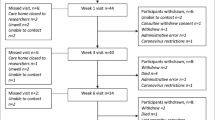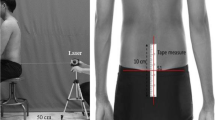Abstract
Background
Some factors, such as cognitive impairment, can attenuate the effectiveness of rehabilitation. We hypothesized that handgrip strength (HGS) might be one of the independent factors affecting the activities of daily living (ADL) improvements in patients with fractures.
Aims
This study aimed to evaluate the relationship between HGS and improvement in ADL during rehabilitation, and to assess the factors affecting ADL improvement among older patients ≥ 80 years with fractures.
Methods
This longitudinal study was conducted at a rehabilitation hospital among 427 females aged ≥ 80 years, who underwent fracture rehabilitation. Patients were divided into two groups based on their HGS. Analysis of comparison between the two groups and multivariate linear regression analyses were performed with respect to functional independence measure (FIM) gain during rehabilitation.
Results
FIM gain was significantly lower in the weak HGS group (31.5 [20.0–41.0]) than in the strong HGS group (35.0 [27.5–47.0], p = 0.011). In multivariate linear regression analyses, HGS was significantly associated with FIM gain (coefficient: 0.683, 95% confidence intervals 0.302–1.064, p < 0.001). In addition, Mini-Mental State Examination, necessity of assistance in ADL before injury, length of hospital stays for rehabilitation, and period of rehabilitation per day were significantly associated with FIM gain.
Conclusions
Weak HGS, cognitive impairment, and necessity of assistance in ADL before injury could be independent factors that attenuate the effectiveness of fracture rehabilitation to improve ADL in old female patients. We encourage such patients to undertake more rehabilitation for improving their ADL, and not refrain from rehabilitation due to old age and fracture.


Similar content being viewed by others
Data availability
The data sets generated or analyzed during the current study are not publicly available, because they contain information that could compromise the privacy of the research participants, but are available from the corresponding author upon request.
References
Lars Larsson X, Degens H, Li M et al (2019) Sarcopenia: aging-related loss of muscle mass and function. Physiol Rev 99:427–511. https://doi.org/10.1152/physrev.00061
Lahtinen A, Leppilahti J, Harmainen S et al (2015) Geriatric and physically oriented rehabilitation improves the ability of independent living and physical rehabilitation reduces mortality: a randomised comparison of 538 patients. Clin Rehabil 29:892–906. https://doi.org/10.1177/0269215514559423
Ponten J, Krug E, Baardewijk L et al (2015) Intensive rehabilitation in selected hip fracture patients may optimize care efficiency: a retrospective comparison study. J Rehabil Med 47:278–281. https://doi.org/10.2340/16501977-1917
Bautmans I, Van Arken J, Van Mackelenberg M et al (2010) Rehabilitation using manual mobilization for thoracic kyphosis in elderly postmenopausal patients with osteoporosis. J Rehabil Med 42:129–135. https://doi.org/10.2340/16501977-0486
Bergland A, Thorsen H, Kåresen R (2011) Effect of exercise on mobility, balance, and health-related quality of life In osteoporotic women with a history of vertebral fracture: a randomized, controlled trial. Osteoporos Int 22:1863–1871
Hongo M, Itoi E, Sinaki M et al (2007) Effect of low-intensity back exercise on quality of life and back extensor strength in patients with osteoporosis: a randomized controlled trial. Osteoporos Int 18:1389–1395. https://doi.org/10.1007/s00198-007-0398-9
Malmros B, Mortensen L, Jensen MB et al (1998) Positive effects of physiotherapy on chronic pain and performance in osteoporosis. Osteoporos Int 8:215–221. https://doi.org/10.1007/s001980050057
Papaioannou A, Adachi JD, Winegard K et al (2003) Efficacy of home-based exercise for improving quality of life among elderly women with symptomatic osteoporosis-related vertebral fractures. Osteoporos Int 14:677–682. https://doi.org/10.1007/s00198-003-1423-2
Seematter-Bagnoud L, Frascarolo S, Büla CJ (2018) How much do combined affective and cognitive impairments worsen rehabilitation outcomes after hip fracture? BMC Geriatr. https://doi.org/10.1186/s12877-018-0763-x
Dubljanin-Raspopović E, Marković-Denić L, Matanović D et al (2012) Is pre-fracture functional status better than cognitive level in predicting short-term outcome of elderly hip fracture patients? Arch Med Sci 8:115–122. https://doi.org/10.5114/aoms.2012.27291
Martínez-Arnau FM, Buigues C, Fonfría-Vivas R et al (2020) Respiratory muscle strengths and their association with lean mass and handgrip strengths in older institutionalized individuals. J Clin Med 9:2727. https://doi.org/10.3390/JCM9092727
Lima TRL, Almeida VP, Ferreira AS et al (2019) Handgrip strength and pulmonary disease in the elderly: what is the link? Aging Dis 10:1109. https://doi.org/10.14336/AD.2018.1226
Beyer SE, Sanghvi MM, Aung N et al (2018) Prospective association between handgrip strength and cardiac structure and function in UK adults. PLoS ONE. https://doi.org/10.1371/JOURNAL.PONE.0193124
Cruz-Jentoft AJ, Baeyens JP, Bauer JM et al (2018) Associations of grip strength with cardiovascular, respiratory, and cancer outcomes and all cause mortality: prospective cohort study of half a million UK Biobank participants. BMJ. https://doi.org/10.1136/BMJ.K1651
Cruz-Jentoft AJ, Pierre Baeyens J, Bauer JM et al (2010) Sarcopenia: European consensus on definition and diagnosis Report of the European Working Group on Sarcopenia in Older People. Age Ageing 39:412–423. https://doi.org/10.1093/ageing/afq034
Charlson ME, Pompei P, Ales KL et al (1987) A new method of classifying prognostic comorbidity in longitudinal studies: development and validation. J Chronic Dis 40:373–383. https://doi.org/10.1016/0021-9681(87)90171-8
Charlson ME, Karnik J, Wong M et al (2005) Does experience matter? A comparison of the practice of attendings and residents. J Gen Intern Med 20:497–503. https://doi.org/10.1111/j.1525-1497.2005.0085.x
Schneeweiss S, Maclure M (2000) Use of comorbidity scores for control of confounding in studies using administrative databases. Int J Epidemiol 29:891–898. https://doi.org/10.1093/ije/29.5.891
Lee SY, Ahn S, Kim YJ et al (2018) Comparison between dual-energy x-ray absorptiometry and bioelectrical impedance analyses for accuracy in measuring whole body muscle mass and appendicular skeletal muscle mass. Nutrients. https://doi.org/10.3390/nu10060738
Fang W-H, Yang J-R, Lin C-Y et al (2020) Accuracy augmentation of body composition measurement by bioelectrical impedance analyzer in elderly population. Medicine. https://doi.org/10.1097/MD.0000000000019103
Kim M, Shinkai S, Murayama H et al (2015) Comparison of segmental multifrequency bioelectrical impedance analysis with dual-energy X-ray absorptiometry for the assessment of body composition in a community-dwelling older population. Geriatr Gerontol Int 15:1013–1022. https://doi.org/10.1111/ggi.12384
Bosy-Westphal A, Jensen B, Braun W et al (2017) Quantification of whole-body and segmental skeletal muscle mass using phase-sensitive 8-electrode medical bioelectrical impedance devices. Eur J Clin Nutr 71:1061–1067. https://doi.org/10.1038/ejcn.2017.27
Kim G, Lee S-E, Jun JE et al (2018) Increase in relative skeletal muscle mass over time and its inverse association with metabolic syndrome development: a 7-year retrospective cohort study. Cardiovasc Diabetol 17:23. https://doi.org/10.1186/s12933-018-0659-2
Rubenstein LZ, Harker JO, Salvà A et al (2001) Screening for undernutrition in geriatric practice: developing the Short-Form Mini-Nutritional Assessment (MNA-SF). J Gerontol A Biol Sci Med Sci 56:M366–72. https://doi.org/10.1093/gerona/56.6.M366
Folstein MF, Folstein SE, McHugh PR (1975) “Mini-mental state”. A practical method for grading the cognitive state of patients for the clinician. J Psychiatr Res 12:189–198. https://doi.org/10.1016/0022-3956(75)90026-6
Tatari F, Farnia V, Kazemi F (2011) Mini Mental State Examination (MMSE) in first episode of psychosis. Iran J Psychiatry 6:158–160
Gosman-Hedstrom G, Svensson E (2000) Parallel reliability of the functional independence measure and the Barthel ADL index. Disabil Rehabil 22:702–715. https://doi.org/10.1080/09638280050191972
McGrath R, Clark BC, Cesari M et al (2020) (2020) Handgrip strength asymmetry is associated with future falls in older Americans. Aging Clin Exp Res 339:2461–2469. https://doi.org/10.1007/S40520-020-01757-Z
Chen LK, Liu LK, Woo J et al (2014) Sarcopenia in Asia: consensus report of the Asian working group for sarcopenia. J Am Med Dir Assoc 15:95–101
Wang L, Yu W, Yin X et al (2021) Prevalence of osteoporosis and fracture in China: the China Osteoporosis Prevalence Study. JAMA Netw Open. https://doi.org/10.1001/JAMANETWORKOPEN.2021.21106
Lee K, Lee JY, Kim YH (2021) Low grip strength and muscle mass increase the prevalence of osteopenia and osteoporosis in elderly women. Healthcare. https://doi.org/10.3390/HEALTHCARE9040476
Nawata T, Kubo M, Nomura T et al (2018) Change in muscle volume after steroid therapy in patients with myositis assessed using cross-sectional computed tomography. BMC Musculoskelet Disord. https://doi.org/10.1186/s12891-018-2008-8
Kim SY, Lee JK, Oh DJ et al (2019) Depression and incident hip fracture: a longitudinal follow-up study using a national sample cohort. Medicine (Baltimore). https://doi.org/10.1097/MD.0000000000016268
Acknowledgements
We would like to acknowledge all the patients who agreed to participate in this study.
Funding
No funding was received for the support of this study.
Author information
Authors and Affiliations
Corresponding author
Ethics declarations
Conflict of interest
The authors declare that they have no conflicts of interest.
Ethical approval
All experimental procedures were performed in accordance with the principles of the Declaration of Helsinki. This study was approved by the institutional review board of the hospital (approval ID: 19-93).
Informed consent
Written informed consent was obtained from each patient. All participants were given the opportunity to have their data excluded from the study.
Additional information
Publisher's Note
Springer Nature remains neutral with regard to jurisdictional claims in published maps and institutional affiliations.
Rights and permissions
About this article
Cite this article
Ogawa, T., Koike, M. Independent factors that attenuate the effectiveness of fracture rehabilitation in improving activities of daily living in female patients aged 80 years and above. Aging Clin Exp Res 34, 793–800 (2022). https://doi.org/10.1007/s40520-021-01992-y
Received:
Accepted:
Published:
Issue Date:
DOI: https://doi.org/10.1007/s40520-021-01992-y




